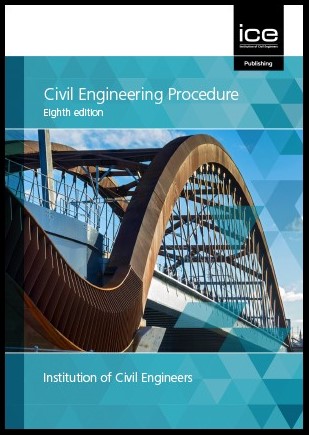Civil Engineering Procedure
The Institution of Civil Engineers (ICE) is a charity and international membership organisation established to ‘...foster and promote the art and science of civil engineering’
Civil Engineering Procedure was first published by ICE in 1963, providing a guide to the stages of work for civil engineering projects such as the design and construction of bridges, tunnels, roads, railways and so on.
The sixth edition was published in 2009 and included updates describing the principles of Public Private Partnership (PPP) and Private Finance Initiative (PFI) projects as well as the emergence of Early Contractor Involvement (ECI).
The seventh edition was published in 2015/16, and included amendments to reflect the introduction of the 2015 CDM Regulations, the NEC3 contract and building information modelling (BIM). It also emphasised the role of civil engineers in building sustainable economies.
The eighth edition, published in October 2020, contains updates including coverage of recent initiatives to improve project and programme delivery, the latest updates to the NEC contracts, and additional case studies that provide insights into real-world practice.
It is a relatively compact book of just 208 pages, which introduce, describe and explain the stages of work for civil engineering projects from concept and promotion through to completion and operation. It is an essential reference guide for students of civil engineering and related disciplines and graduate engineers.
Its contents include:
- Concept and promotion.
- Feasibility studies.
- Procurement and contract strategy.
- Design and Building Information Modelling (BIM).
- Risk management and health, safety and welfare.
- Planning and control of construction.
- Construction management organisation.
- Testing, commissioning and handover.
- Operation, maintenance and asset management.
--The Institution of Civil Engineers
[edit] Related articles on Designing Buildings Wiki
- Civil engineer.
- Construction industry institutes and associations.
- Consultants.
- Direct employment.
- Direct labour.
- Engineer.
- Engineering Council.
- History of the Institution of Civil Engineers.
- Infrastructure.
- Institute of Engineering and Technology.
- Institution of Civil Engineers ICE
- Institution of Structural Engineers.
- Structural engineer.
Featured articles and news
Latest Build UK Building Safety Regime explainer published
Key elements in one short, now updated document.
UKGBC launch the UK Climate Resilience Roadmap
First guidance of its kind on direct climate impacts for the built environment and how it can adapt.
CLC Health, Safety and Wellbeing Strategy 2025
Launched by the Minister for Industry to look at fatalities on site, improving mental health and other issues.
One of the most impressive Victorian architects. Book review.
Common Assessment Standard now with building safety
New CAS update now includes mandatory building safety questions.
RTPI leader to become new CIOB Chief Executive Officer
Dr Victoria Hills MRTPI, FICE to take over after Caroline Gumble’s departure.
Social and affordable housing, a long term plan for delivery
The “Delivering a Decade of Renewal for Social and Affordable Housing” strategy sets out future path.
A change to adoptive architecture
Effects of global weather warming on architectural detailing, material choice and human interaction.
The proposed publicly owned and backed subsidiary of Homes England, to facilitate new homes.
How big is the problem and what can we do to mitigate the effects?
Overheating guidance and tools for building designers
A number of cool guides to help with the heat.
The UK's Modern Industrial Strategy: A 10 year plan
Previous consultation criticism, current key elements and general support with some persisting reservations.
Building Safety Regulator reforms
New roles, new staff and a new fast track service pave the way for a single construction regulator.
Architectural Technologist CPDs and Communications
CIAT CPD… and how you can do it!
Cooling centres and cool spaces
Managing extreme heat in cities by directing the public to places for heat stress relief and water sources.
Winter gardens: A brief history and warm variations
Extending the season with glass in different forms and terms.
Restoring Great Yarmouth's Winter Gardens
Transforming one of the least sustainable constructions imaginable.
























